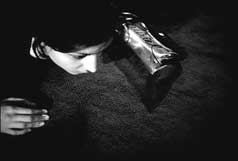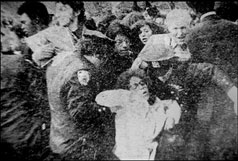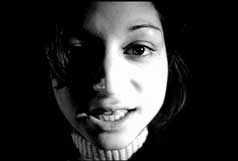4.
The Murder.
There is no real demarcation between this
section of the film and the preceding one. After leaving her apartment
Emma walks to an executive building, enters, takes an elevator, goes down
a corridor and into the factory owner's office, and (after an exchange
of words) shoots him. The screen remains fractured throughout, and the
two voices continue their "dialogue".
However, there is an intensification of the general
tendency toward decomposition. Increasingly the voices of Emma and Muriel
are out of temporal alignment with the image, sometimes jumping ahead
to events which have not yet been depicted, and sometimes lapsing back
to anterior moments, in which might best be described as a linguistic
vertigo. They also echo each other with greater and greater persistence,
often reducing the words they speak to mere reverberant sounds. Actions
––Emma's entry into the office, the firing of the gun, the
dialing of the telephone afterwards–– are shown over and over
again, from different angles, until they seem devoid of meaning.
The fantasmatic nature of Emma's behavior also becomes
increasingly evident in this section of Splits. The fact that
she inhibits a "time outside a time" ––a space in
which the same performance is endlessly replayed, although the actors
may change– is indicated not only by the film's formal repetitions,
but through a number of additional theatrical and cinematic signifiers.
Emma "(waits) in a frozen set for hours, rehearsing lines, inventing
new ones"; she repeats "her words like a love poem, so many
times, over and over"; she describes her verbal exchange with the
factory owner as a "text".
After what seems to be yet another metaphoric reference
to the cinematic apparatus at the climatic moment of this sequence ("I
hid my eyes when the shots crashed. There was another take, then another
take ... the lights stay lit") that reference is abruptly literalized:
we are given a shot of Emma's arm reaching with the gun from frame left
into the view-finder of a camera aimed at her from frame right. Twice
we watch while a male crew member turns over the chair on which the factory
owner sits, sliding him to the ground. |


